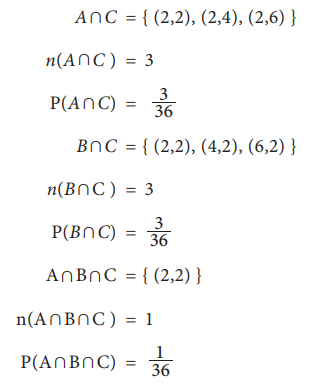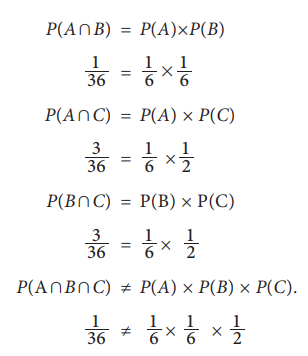Probability Theory - Independent Events | 11th Statistics : Chapter 8 : Elementary Probability Theory
Chapter: 11th Statistics : Chapter 8 : Elementary Probability Theory
Independent Events
Independent
Events
For
any two events A and B of a random experiment, if P(A/B)
= P(A), then knowledge of the event B
does not change the probability for the occurrence of the event A.
Such events are called independent events.
If
P(A/B) = P(A), then

=> P(A∩B) = P(A) × P(B).
Similarly,
the relation P(B/A) = P(B) also indicates the independence
of the events A and B.
Definition
Two events A and B are said to be independent
of one another, if
P(A∩B) = P(A) × P(B).
Example 8.16
In
tossing a fair coin twice, let the events A and B be defined as A:
getting head on the first toss, B: getting head on the second toss.
Prove that A and B are independent events.
Solution:
The
sample space of this experiment is
S = {HH, HT, TH, TT}.
The
unconditional probabilities of A and B are P(A) = 1/2= P(B).
The event of getting heads in both the tosses is represented by
A∩B.
The outcome of the experiment in favour of the occurrence of this event is HH.
Hence, P(A∩B) = 1/4.
P(A∩B) = P(A) × P(B) holds.
Thus, the events A and B are independent events.
Example 8.17
In the experiment of rolling a pair of dice, the events A, B and
C are defined as A : getting 2 on the
first die, B : getting 2 on the
second die, and C : sum of the faces
of dice is an even number. Prove that
the events are pair wise independent but not mutually independent?
Solution:
S= { (1,1), (1,2), (1,3), (1,4), (1,5), (1,6),
(2,1), (2,2), (2,3), (2,4), (2,5), (2,6),
(3,1), (3,2), (3,3), (3,4), (3,5), (3,6),
(4,1), (4,2), (4,3), (4,4), (4,5), (4,6),
(5,1), (5,2), (5,3), (5,4), (5,5), (5,6),
(6,1), (6,2), (6,3), (6,4), (6,5), (6,6) }
n(S) = 36
The outcomes which are favourable to the occurrence of these
events can be listed below:
A = { (2,1), (2,2), (2,3), (2,4), (2,5), (2,6) }
n(A) = 6
P(A) = 6/36=1/6
B = { (1,2), (2,2), (3,2), (4,2), (5,2), (6,2) }
n(B) = 6
P(B) = 6/36=1/6
C = { (1,1), (1,3), (1,5), (2,2), (2,4), (2,6), (3,1), (3,3),
(3,5),
(4,2), (4,4), (4,6), (5,1), (5,3), (5,5), (6,2), (6,4), (6,6) }
n (C) = 18
P(C) = 18/36=1/6
A∩B = { (2,2) }
n(A∩B ) = 1
P(A∩B) = 1/36

The following relations may be obtained from these probabilities

The above relations show that when the events A, B
and C are considered in pairs, they
are independent. But, when all the three events are considered together, they
are not independent.
Related Topics